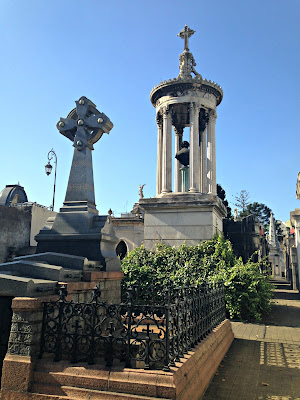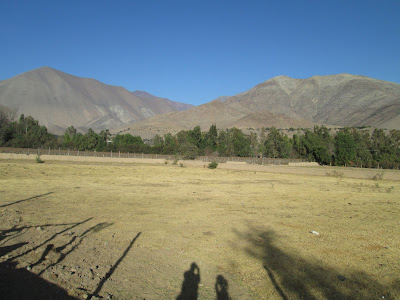Saturday we once again left La Serena! Haha. We slept in until about 8:30 since we were exhausted from the day before, and then got ready and caught a bus out about one hour east of La Serena to Vicuña. Vicuña is one of the major cities in Valle del Elqui, a beautiful, beautiful area on the edge of the Andes. This area is known for their pisco, their clear skies, and beautiful mountain views. I have some beautiful panorama photos on my phone I cannot upload yet but if I get access to them I will share them. They are gorgeous.
We started off the day with a tour of the Capel Pisco Distillery. The really big Mistral distillery is in another town in the valley, Pisco Elqui, but that is about another hour from Vicuña and we did not really have time to go out there and spend much time before we would have to return, so we chose to visit one of the ones in Vicuña. Pisco is such a popular alcohol here, so I was excited to see how it is made and how it is similar/different to wine.
We got to walk through the factory and learn all about the steps and processes involved with making pisco! They use special grapes to make the white wine that eventually becomes pisco, and they are very sweet grapes, similar to Moscatel because they need to sugar to ferment into more alcohol. They go through the same processing and fermenting as grapes do to make wine, and actually are made into a white wine! It only ferments for 20 days though, so the sugar concentration is still very high. Then that wine goes through the distilling process, which is how they turn it into basically straight alcohol which is used for pisco. It is at about an 80% concentration, and then they add water to dilute it down to the normal pisco concentrations, which vary between 30-50% alcohol depending on the brand and the grade of the pisco. Our guide also explained the differences between the different types of pisco which was interesting and definitely nice to know! It was also interesting to me that they store it in barrels like wine, and the wood of the barrel has an impact on the color of the pisco and the flavor! That explains why some pisco is more yellow, while some is basically clear. (The clear pisco never actually touches a barrel!)
The distillery was super cool and we got to do some taste testing at the end. They make so many different types of pisco. They also had a really cool museum there of historical stuff and they old hand machines they used to use to process the grapes and make the pisco. Another cool part was looking at how the bottles have changed throughout the years!
Here are a few pictures from the tour.
The distilling tanks!
The bottling room! So cool. Only 5 employees actually work in there, because most of it is done mechanically.
The view around the distillery was okay I guess... :)
After the tour we walked back to the center of Vicuña and grabbed lunch at a cute little homestyle restaurant. Then we decided to just walk around the town and explore! It was so small and so cute. We came across a cool bug museum for like $1 so we decided to check it out! It was really interesting and also slightly disturbing. Seeing the giant spiders and strange insects bothered me. They look like something out of a movie, so it is crazy to think that those actually exist and a lot of them are living in South America. Remind me not to go hiking in the jungle YUCK.
Here are a few pictures from that! They also had some taxidermized animals and some super cool fossils.
The size of these spiders is actually horrifying.
Super cool fossilized bird/dinosaur thing! I can't remember its name haha.
After the museum we just walked around the outskirts of Vicuña to kill time before our observatory tour. Eventually we found a park and just sat and relaxed, taking in the beautiful views. At around 8pm our tour guide came and picked us up for the observatory! There are tons of observatories in this region of Chile, and we got to go to the Mamalluca Observatory right outside of Vicuña.
Our guide asked if we wanted English or Spanish tickets, and we said we didn't care, so he chose English ones because he said the group would probably be smaller. Thank goodness he did! Our English group was about 11 people, compared to the giant Spanish group which was probably like 75 people and then split into two groups. There was a mom and daughter from Iowa in our group which I thought was fun! The daughter is around my age and is teaching English in Santiago for a year, and her mom had come down to visit for a week. There were also two Chilean couples in our group, whose English wasn't great, but they wanted to do the smaller group, and the guide was good about speaking some Spanish for them too.
We started out in the big observatory dome looking at various planets and stars! It is really cool because the telescope is super intense and actually GPS run. He would just input whatever we wanted to look at and it would automatically move and focus to find it. Check it out!
Through the telescope we got to look at Venus, Jupiter and 4 of its moons, Saturn and some of its moons, and our moon super zoomed in. It was SO cool. We could see Saturn's rings and the swirling atmosphere of Venus. The moon was pretty big that night so the sky was kind of bright, but we still saw a lot. It was clear and beautiful. We also looked at some stars, which is so deceiving. We see one dull star from earth, but in the telescope that one dull star is actually a huge group of stars.
Then we went outside to check out some constellations and hear their history. Our guide was telling us some interesting stories about how the constellations are different depending on the history. The Greeks had different names for the same constellation than the Incas did, and so on. Super interesting how they saw different things. It was also so weird because we are on the southern hemisphere so all the constellations we could see were upside down! And we couldn't see the North Star or the Big Dipper or anything because those are clearly on the north side. Then we looked at some stuff in an outdoor telescope and got to take some moon pictures through the scope! I was glad because I really wanted to be able to show people the amazing views we had!
Crystal clear and gorgeous!
Check out those sweet craters!
Then we went inside and our guide showed us a cool astronomical software program their computer has and was giving us some history. It was such a fun night and I am so glad we did it. Chile is the best place in the world for astronomy, and currently has 50% of the world's giant telescopes and research stuff. In a few years, the guide said Chile will have 75%. The reason it is so good is because they only have about 20 cloudy days per year! Also, the mountain area is at a higher altitude so the atmosphere is better for it as well. You can actually visually see the Milky Way in the sky which is the coolest thing I have ever seen! There is a super GIANT telescope that is in the process of being built right now that will be eventually placed in Chile.
We left Mamalluca and got back to our hostel in La Serena at about 12:30am and went promptly to bed. Another successful day of our weekend vacation! :)

















































